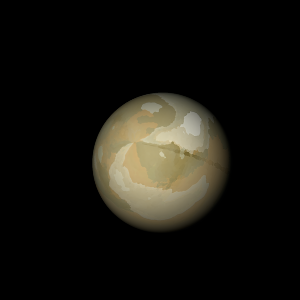|
|
Space Astro
|
Info for exoplanet "Skollao"
| Scientific (actual) data |
|---|
| Planet | Kepler-192 c |
| Planet status | Confirmed |
| Radius | 0.249 |
| Orbital period | 21.2234 |
| Semi major axis | 0.15 |
| Discovered | 2014 |
| Updated | 2021-02-05 |
| Tconj | 2455000 |
| Impact parameter | 0.82 |
| Publication | Announced on a website |
| Detection type | Primary Transit |
| Alternate names | 2MASS J19114030+4535343 c, K00584.02, KIC 9146018 c, KOI-584 c, KOI-584.02, WISE J191140.31+453534.2 c |
| Star name | Kepler-192 |
| Right ascension | 287.92° |
| Declination | 45.59° |
| Mag j | 12.892 |
| Mag h | 12.512 |
| Mag k | 12.427 |
| Star distance | 664.14 |
| Star metallicity | -0.153 |
| Star radius | 1.01 |
| Star temperature | 5479 |
| Star alternate names | 2MASS J19114030+4535343, KIC 9146018, KOI-584, WISE J191140.31+453534.2 |
| Wikipedia article | Kepler-192 c |
Back
| |
| Fictional info (?) |
|---|
| Suggested name | Skollao |
| Planet type | Planet |
| It is named after the deity Skollao, the bringer of hate.
Like Cortia Prax, Skollao has been orbiting Kepler-192 within Stethrymr's orbit as an inferior planet, and never exceeds 23 degrees away from Kepler-192.
The smooth Borealis basin in the northern hemisphere covers 24 percent of the planet and may be a giant impact feature.
Optical ground-based telescopes are typically limited to resolving features about 420 kilometers across when Skollao is closest because of Earth's atmosphere.
The largest moon, Prosthone, has a diameter greater than that of the planet Mercury.
Its north and south poles, therefore, lie where most other planets have their equators. Observations from Earth have shown seasonal change and increased weather activity as Skollao approached its equinox 4 years ago. |
| Atmosphere | Krypton | 63% |
| Hydrogen | 28% |
| Sulfur dioxide | 7.9% |
| 2H2O | 0.0073% |
| Ammonia | 0.00026% |
| Atmospheric pressure | 80 bar |
 |
| Moon | Carophe-pro | Very small irregular gaseous asteroid |
| Prosthone | Medium-sized irregular crater-filled moon |
| Google search for Skollao |
|
Website by Joachim Michaelis
|
|
|
|